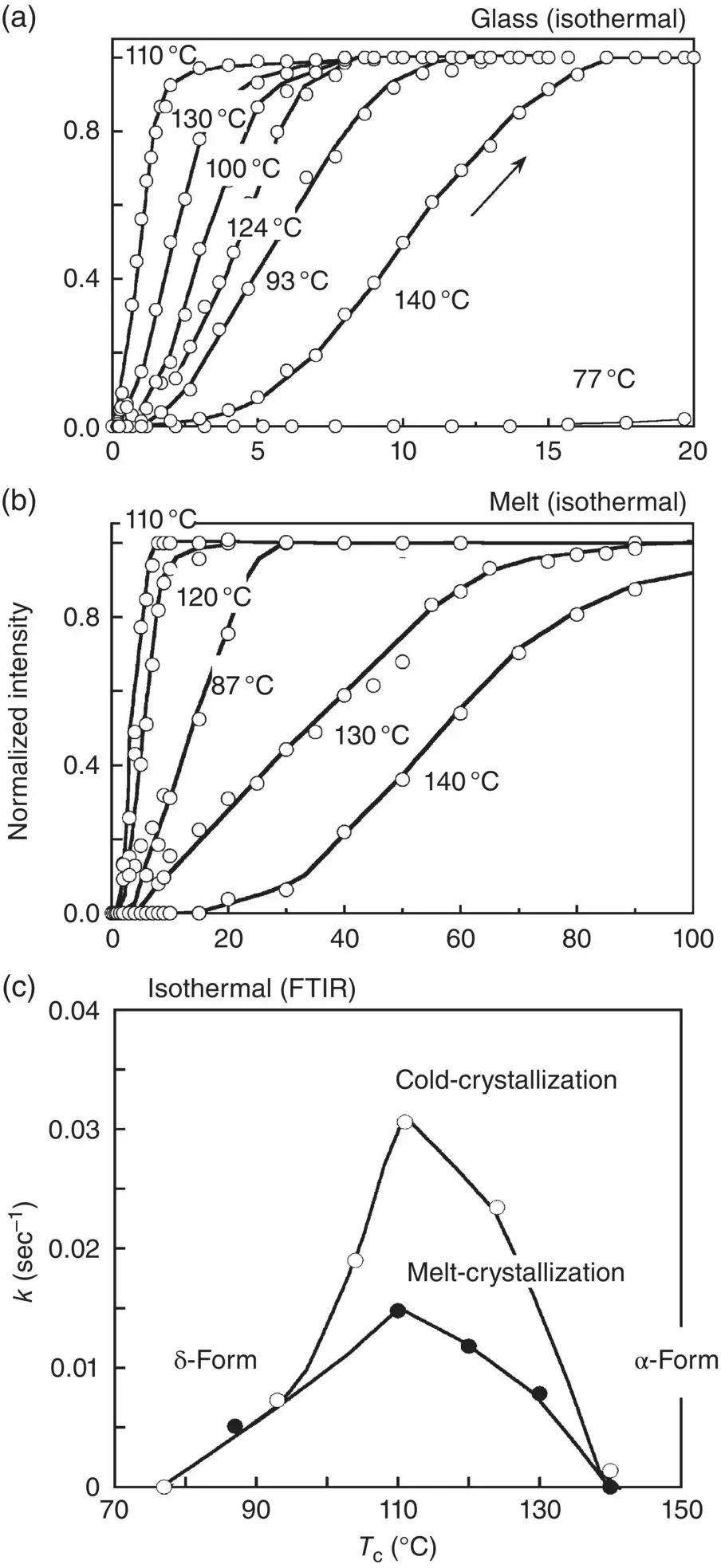Poly(lactic acid)
Здесь есть возможность читать онлайн «Poly(lactic acid)» — ознакомительный отрывок электронной книги совершенно бесплатно, а после прочтения отрывка купить полную версию. В некоторых случаях можно слушать аудио, скачать через торрент в формате fb2 и присутствует краткое содержание. Жанр: unrecognised, на английском языке. Описание произведения, (предисловие) а так же отзывы посетителей доступны на портале библиотеки ЛибКат.
- Название:Poly(lactic acid)
- Автор:
- Жанр:
- Год:неизвестен
- ISBN:нет данных
- Рейтинг книги:5 / 5. Голосов: 1
-
Избранное:Добавить в избранное
- Отзывы:
-
Ваша оценка:
- 100
- 1
- 2
- 3
- 4
- 5
Poly(lactic acid): краткое содержание, описание и аннотация
Предлагаем к чтению аннотацию, описание, краткое содержание или предисловие (зависит от того, что написал сам автор книги «Poly(lactic acid)»). Если вы не нашли необходимую информацию о книге — напишите в комментариях, мы постараемся отыскать её.
Poly(lactic acid) Synthesis, Structures, Properties, Processing, Applications, and End of Life
Poly(lactic acid) Synthesis, Structures, Properties, Processing, Applications, and End of Life, Second Edition
Poly(lactic acid) — читать онлайн ознакомительный отрывок
Ниже представлен текст книги, разбитый по страницам. Система сохранения места последней прочитанной страницы, позволяет с удобством читать онлайн бесплатно книгу «Poly(lactic acid)», без необходимости каждый раз заново искать на чём Вы остановились. Поставьте закладку, и сможете в любой момент перейти на страницу, на которой закончили чтение.
Интервал:
Закладка:

FIGURE 6.10 Temperature dependence of 2D X‐ray diffraction patterns of the oriented PLLA mesophase measured in the heating process.
Source: Reproduced from Wasanasuk et al., Macromolecules 2011, 44, 9650–9660.

FIGURE 6.11 The temperature dependence of the crystallite size estimated for the equatorial and meridional directions of the oriented PLLA sample during the cold crystallization process starting from the meso form.
Source: Reproduced from Wasanasuk et al., Macromolecules 2011, 44, 9650–9660.
6.3.3 Mechanically Induced Phase Transition
The study of the mechanically induced transition from the α to β form is important for the purpose of improving the mechanical properties of the bulk PLLA samples. As speculated from the sample preparation condition of the β form, the α‐to‐β transformation was considered to be induced primarily by shear applied along the helix axis of the α form [60]. Figure 6.13shows the 2D X‐ray diffraction patterns measured for the oriented α form samples stretched at 165°C at different drawing ratios. The drawing ratio (DR) of 6 gave almost pure and highly‐oriented β form. The δ form was mainly obtained in the sample of DR 5. The stretching at DR 3 gave the X‐ray diffraction pattern similar to that of the original α form, but the diffraction peaks are appreciably broad and diffuse. This state is named the disordered α form (α d) [20]. In this way, the stretching of the oriented α form at 165°C (below the melting point) induces the stepwise transformation of α → α d→ δ → β in the solid state as the draw ratio increases.

FIGURE 6.12 (a) and (b) Time dependence of normalized intensity of the crystallization sensitive IR band at 921 cm −1measured in the isothermal crystallization processes at the various T c. (c) Crystallization temperature dependence of the crystallization rate constant k estimated from the data (a) and (b).
Source: Reproduced from Wasanasuk et al., Macromolecules 2011, 44, 9650–9660.
Another experiment was performed by in situ measurement of the 2D WAXD pattern under a constant tensile stress in the continuous heating process beyond the melting point of the α form [20]. As shown in Figure 6.14, the starting sample was a highly oriented α form. A 1 MPa tensile stress was applied along the chain axis. At around 153°C, the X‐ray diffraction pattern changed to that of the highly diffuse diffraction spots, i.e., the transformation to the α dform. Further heating changed the X‐ray pattern to that of the δ form (175°C), which finally disappeared at around 185°C. That is to say, the δ form was melted under tension at this temperature. However, the further increase of temperature by only 2°C caused the appearance of the X‐ray diffraction pattern of the highly oriented β form with the characteristic diffuse pattern (in addition to a small amount of the α dphase). The β form remained up to 207°C and finally disappeared at about 210°C. The process may be summarized as follows: the α form subjected to a tensile force → α d→ δ → melt → β → melt. In this experiment, the phase transition temperature was high compared with those observed under normal conditions, which might be due to the overstressed state of the oriented sample subjected to a tensile force.
In this way, two different types of the formation process of the α to β form seem to exist. One is a solid‐state transition via the α dand δ forms at a relatively low temperature below the melting point (100–170°C; refer to Figure 6.13). Another one is observed near the melting point. The starting α form changes to the α dform and to the δ form, then the melt of the δ form occurs in a highly superheated state, followed by the recrystallization to an extremely highly oriented β form (refer to Figure 6.14).
The more concrete image of the transformation process from the α to β form is discussed here by referring to the above‐mentioned knowledge. As already seen in the previous section, PLLA β form takes a complicated and low‐symmetric packing structure ( P 1) consisting of the six chains in the orthogonal unit cell. It must be noted that the chain packing mode is not random, but the upward and downward chains are packed in a systematic (but complicated) way. The geometrical relation of the crystal structure between the α (δ) and β forms is shown in Figure 6.15a. The unit cell size and chain positions in the ab plane are almost the same among these three crystalline forms. In the unit cells of the α and δ forms, the upward (U) and downward (D) chain stems are arrayed alternately at the corner and center positions of the unit cell along the a axis. In the crystal lattice of the β form, the U and D chain stems are arranged in a different way. How can we relate the chain packing structures between the α (δ) and β forms? One possible model is illustrated in Figure 6.15b. The three diagonal arrays (A, B and A along the 110 planes) are focused now [see ( b − 1)]. By applying shear stress to the crystallite, the diagonal arrays of A are slipped in the positive direction along the 110 planes, while the B arrays in the opposite direction [( b − 2)]. As a result, the new packing structure of U and D chain stems is created as shown in ( b − 3). These chains are displaced furthermore along the b axis so that the total packing energy becomes lower, resulting in the β form [( b − 4)]. During this process, the molecular chains change the conformation from 10/3 to 3/1 form. At the same time, the relative heights of the neighboring chains are disordered, and the domain size becomes smaller as known from the change of the X‐ray diffraction width. The schematic illustration of the crystallite‐size change is given in Figure 6.15c.

FIGURE 6.13 The 2D WAXD patterns measured at 25°C for the uniaxially oriented PLLA samples prepared by drawing the oriented αform at 165°C. The drawing ratio DR = (L − L 0)/L 0for the sample length L and L 0(initial value).
Source: Reproduced from Wang et al., Macromolecules 2017, 44, 3285–3300.

FIGURE 6.14 Temperature dependence of 2D X‐ray diffraction pattern of highly oriented α form under a constant tensile force (about 1 MPa).
Source: Reproduced from Wang et al., Macromolecules 2017, 44, 3285–3300.
6.4 MICROSCOPICALLY‐VIEWED STRUCTURE‐MECHANICAL PROPERTIES OF PLA
The estimation of the mechanical property of an ideal crystalline state, or the ultimate mechanical property, is important as a guiding principle for the development of PLA samples with excellent mechanical properties. The theoretical prediction of mechanical properties with high reliability can be made for the first time by using the accurate crystal structure information and the credible potential functional parameters, which can reproduce the various kinds of the experimentally obtained physical constants including the vibrational spectroscopic data [61–72]. The 3D elastic constant tensors of PLLA α [5], δ [9] and β forms [20] were calculated using the above‐mentioned X‐ray‐analyzed crystalline structures:
Читать дальшеИнтервал:
Закладка:
Похожие книги на «Poly(lactic acid)»
Представляем Вашему вниманию похожие книги на «Poly(lactic acid)» списком для выбора. Мы отобрали схожую по названию и смыслу литературу в надежде предоставить читателям больше вариантов отыскать новые, интересные, ещё непрочитанные произведения.
Обсуждение, отзывы о книге «Poly(lactic acid)» и просто собственные мнения читателей. Оставьте ваши комментарии, напишите, что Вы думаете о произведении, его смысле или главных героях. Укажите что конкретно понравилось, а что нет, и почему Вы так считаете.












